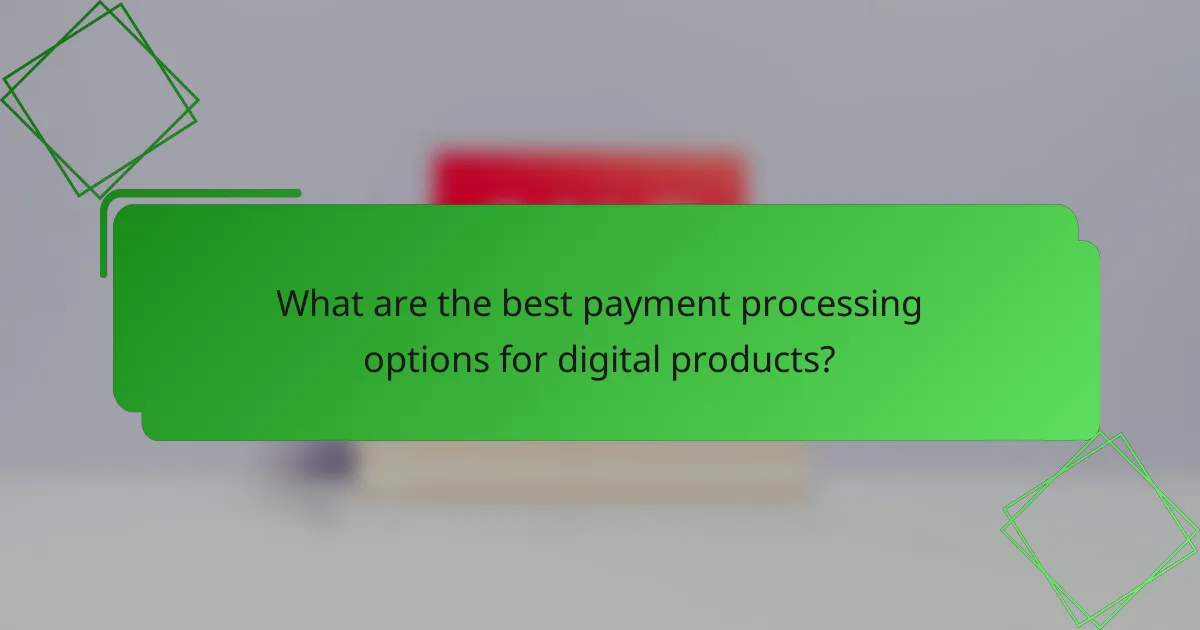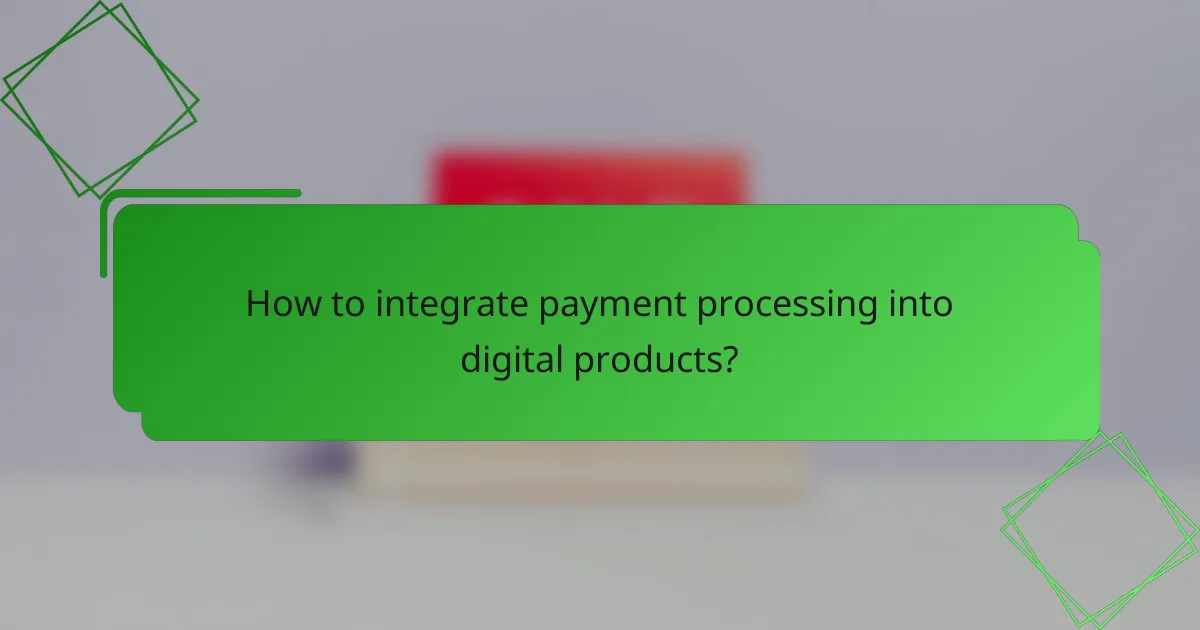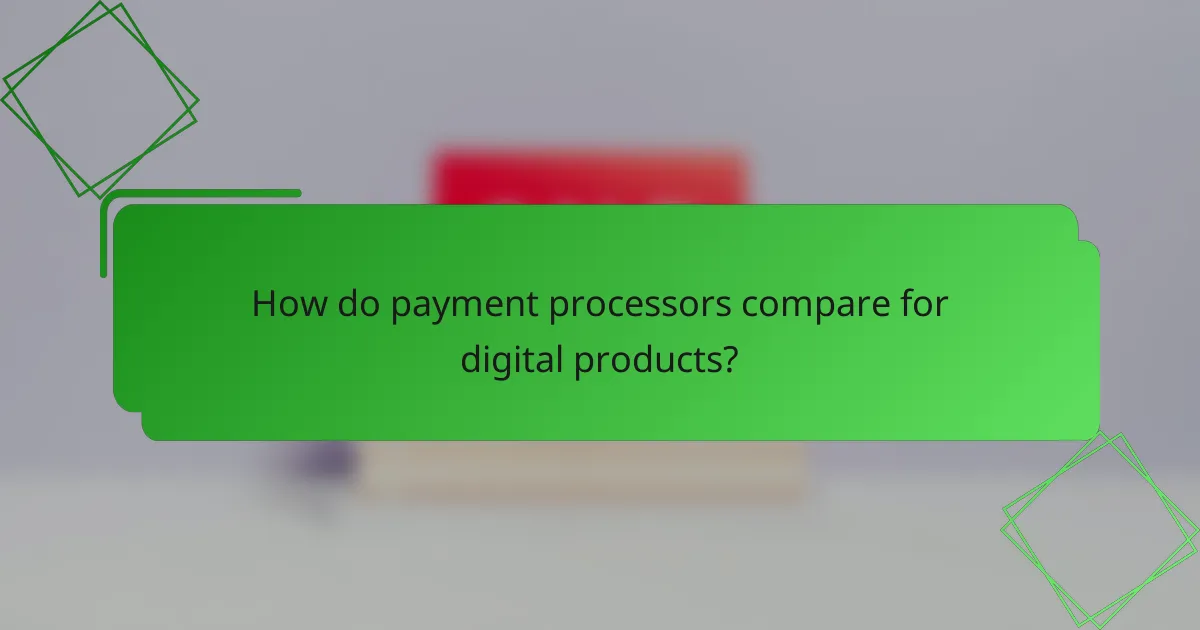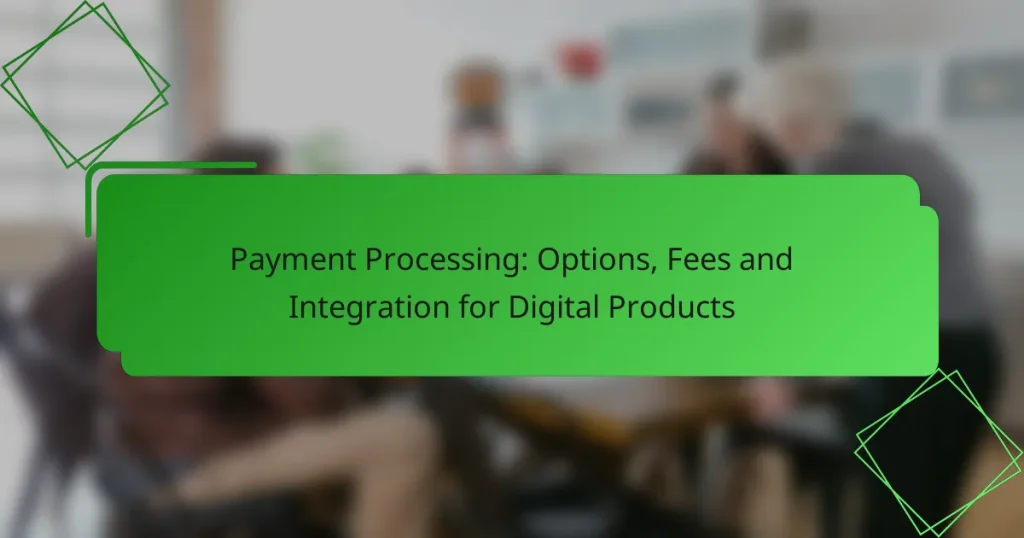When selling digital products, choosing the right payment processing option is crucial for success. Popular platforms like PayPal, Stripe, Square, and Authorize.Net offer various features and fee structures tailored to different business needs. Understanding the associated costs and effectively integrating these payment gateways into your platform can enhance security and improve customer satisfaction.

What are the best payment processing options for digital products?
The best payment processing options for digital products include PayPal, Stripe, Square, and Authorize.Net. Each platform has unique features, fees, and integration capabilities that cater to different business needs.
PayPal for digital transactions
PayPal is a widely recognized payment processor that allows businesses to accept payments online easily. It is particularly suitable for digital products due to its user-friendly interface and strong buyer protection policies.
When using PayPal, consider its transaction fees, which typically range from 2.9% plus a fixed fee per transaction. PayPal also offers features like invoicing and subscription management, making it versatile for various digital sales models.
Stripe for subscription services
Stripe is an excellent choice for businesses offering subscription-based digital products. It provides robust APIs that allow for seamless integration with websites and applications, enabling recurring billing and automated payment processing.
Stripe’s fees are similar to PayPal’s, generally around 2.9% plus a fixed fee per transaction. Additionally, it supports multiple currencies and payment methods, making it suitable for international sales.
Square for e-commerce
Square is ideal for e-commerce businesses looking to sell digital products alongside physical goods. Its comprehensive suite includes payment processing, inventory management, and sales analytics.
Square charges a flat rate of about 2.6% plus 10 cents per transaction, which simplifies budgeting for fees. The platform also offers a free online store setup, making it accessible for small businesses venturing into digital sales.
Authorize.Net for small businesses
Authorize.Net is a reliable payment gateway for small businesses, particularly those focused on digital products. It offers various features, including fraud detection and customer support, which are essential for maintaining trust in online transactions.
Fees for Authorize.Net typically include a monthly gateway fee and transaction fees around 2.9% plus a fixed amount. This structure can be beneficial for businesses that process a high volume of transactions, as it allows for predictable costs.

What fees are associated with payment processing?
Payment processing fees vary by provider and can include transaction fees, monthly fees, and chargeback fees. Understanding these costs is essential for budgeting and maximizing profit margins when selling digital products.
Transaction fees for PayPal
PayPal typically charges a transaction fee of around 2.9% plus a fixed fee based on the currency. For example, in the United States, the fixed fee is $0.30 per transaction. These fees can add up, especially for low-cost digital products.
Consider the volume of transactions you expect. If you process a high number of small transactions, the fees can significantly impact your overall revenue. PayPal also offers discounted rates for businesses with higher sales volumes.
Stripe’s pricing structure
Stripe charges a standard fee of 2.9% plus $0.30 per transaction, similar to PayPal. However, Stripe’s pricing can vary based on the country and the type of transaction, such as international payments or currency conversion fees.
For businesses that require advanced features, Stripe offers additional services like subscription billing and fraud prevention, which may incur extra costs. Evaluate these features against your needs to determine if the benefits justify the fees.
Square’s flat-rate fees
Square employs a flat-rate fee structure, charging 2.6% plus $0.10 per transaction for online sales. This simplicity makes it easy to calculate costs, especially for businesses with predictable sales patterns.
Square also provides tools for invoicing and inventory management, which can be beneficial for digital product sellers. However, be aware that Square’s fees may be higher for certain types of transactions, such as international sales or card-not-present transactions.

How to integrate payment processing into digital products?
Integrating payment processing into digital products involves selecting a payment gateway and implementing it within your platform. This ensures secure transactions and a seamless user experience, which is crucial for customer satisfaction and retention.
Using APIs for Stripe integration
Stripe offers a robust API that allows developers to integrate payment processing directly into their applications. This method provides flexibility and customization, enabling businesses to tailor the payment experience to their needs.
To get started, sign up for a Stripe account and obtain your API keys. Use the Stripe documentation to implement features like payment forms, subscriptions, and invoicing. Ensure you handle sensitive data securely to comply with PCI standards.
Embedding PayPal buttons
Embedding PayPal buttons is a straightforward way to accept payments without extensive coding. PayPal provides customizable button options that can be added to your website or application with minimal effort.
To embed a button, create a PayPal business account, generate the button code, and insert it into your HTML. This method is user-friendly and allows customers to pay using their PayPal accounts or credit cards, enhancing conversion rates.
Setting up Square with e-commerce platforms
Square integrates seamlessly with various e-commerce platforms like WooCommerce and Shopify, making it easy to set up payment processing. This integration allows you to manage transactions, inventory, and customer data from a single dashboard.
To set up Square, create an account and connect it to your e-commerce platform through the respective app or plugin. Be aware of transaction fees, which typically range from 2.6% + 10¢ per transaction, and ensure your platform supports Square to avoid compatibility issues.

What are the security considerations for payment processing?
Security is critical in payment processing to protect sensitive financial information and maintain customer trust. Key considerations include compliance with industry standards, implementing fraud prevention measures, and ensuring secure data transmission.
PCI compliance requirements
Payment Card Industry Data Security Standard (PCI DSS) compliance is essential for businesses that handle credit card transactions. These requirements include maintaining a secure network, protecting cardholder data, and regularly monitoring and testing networks. Non-compliance can lead to hefty fines and increased liability.
To achieve PCI compliance, businesses should conduct regular security assessments, implement strong access control measures, and ensure encryption of cardholder data during transmission. Following these guidelines helps mitigate risks associated with data breaches.
Fraud prevention measures
Fraud prevention is vital for safeguarding payment processing systems. Effective measures include using advanced authentication methods, such as two-factor authentication, and employing machine learning algorithms to detect unusual transaction patterns. These strategies help identify and block fraudulent activities before they impact customers.
Additionally, businesses should regularly review transaction data for anomalies and educate staff on recognizing potential fraud indicators. Implementing a robust fraud prevention strategy not only protects revenue but also enhances customer confidence in the payment process.

What are the prerequisites for choosing a payment processor?
Choosing a payment processor requires understanding your business needs, transaction volumes, and customer preferences. Key factors include aligning your business model with the processor’s offerings and assessing your expected transaction volume to ensure cost-effectiveness.
Business model alignment
Your payment processor should support your specific business model, whether it’s subscription-based, one-time sales, or a marketplace. For instance, if you run a subscription service, look for processors that offer recurring billing features and customer management tools.
Additionally, consider the types of payments you want to accept. Some processors specialize in credit card transactions, while others may offer support for digital wallets or cryptocurrencies. Ensure the processor you choose aligns with your target audience’s preferred payment methods.
Transaction volume assessment
Assessing your transaction volume is crucial for selecting a payment processor that fits your financial needs. If you expect low to moderate transaction volumes, a processor with a pay-as-you-go model may be ideal. Conversely, if you anticipate high volumes, look for options with lower transaction fees that can save you money over time.
As a rule of thumb, if your monthly transactions exceed a certain threshold, negotiating a custom rate with the processor can be beneficial. Keep in mind that many processors offer tiered pricing based on transaction volume, so understanding your expected sales can lead to significant savings.

How do payment processors compare for digital products?
Payment processors for digital products vary significantly in terms of fees, features, and integration capabilities. Understanding these differences is crucial for selecting the right option that aligns with your business needs.
Fees and Costs
Fees for payment processors can range from a few percent of each transaction to flat monthly fees. Common structures include per-transaction fees, monthly fees, and chargeback fees. For example, many processors charge around 2-3% per transaction plus a fixed fee, such as $0.30.
When evaluating costs, consider both the transaction fees and any additional charges for services like fraud protection or currency conversion. Some processors may offer lower transaction fees but higher monthly fees, so it’s essential to calculate the total cost based on your expected sales volume.
Integration Options
Integration options for payment processors vary widely, affecting how easily you can implement them into your digital product platform. Many processors offer APIs, plugins, and SDKs that facilitate seamless integration with popular e-commerce platforms and content management systems.
Consider the technical requirements and support available for integration. Some processors provide extensive documentation and customer support, while others may have limited resources, making the setup process more challenging.
Security and Compliance
Security is a critical factor when selecting a payment processor, especially for digital products. Look for processors that comply with PCI DSS (Payment Card Industry Data Security Standard) to ensure your customers’ payment information is protected.
Additionally, consider features like encryption, tokenization, and fraud detection tools. A processor that prioritizes security can help mitigate risks associated with online transactions and build trust with your customers.
Customer Support
Customer support can significantly impact your experience with a payment processor. Look for providers that offer multiple support channels, such as phone, email, and live chat, and check their availability hours.
Responsive and knowledgeable support can help resolve issues quickly, minimizing downtime and ensuring a smooth transaction process for your customers. Reading reviews and testimonials can provide insights into the quality of support offered by different processors.


